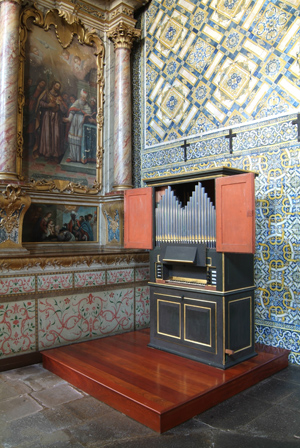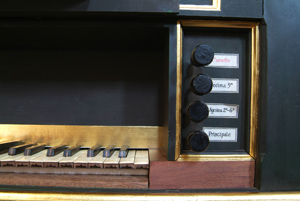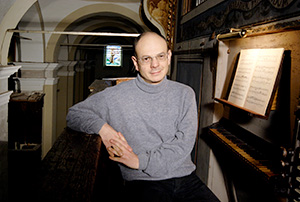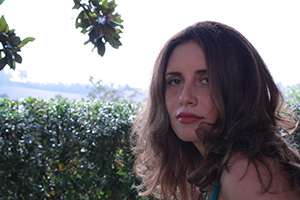
Tuesday, 22 October, 9.30, p.m.
Church and Convent of Santa Clara
Giovannimaria Perrucci: organ
Pamela Lucciarini: soprano
Viva Vivaldi!
Today, as in his time, the fame of Antonio Vivaldi, one of the most celebrated composers of the Italian baroque, goes far beyond his original audience.
Born in Venice on 4 March 1678, he was ordained in 1703. This fact, together with his wild red hair (visible in some famous portraits, with his sharply-etched profile) led to the nickname of Prete rosso (Red priest), a designation referring also to the extremely lively, contagious and highly virtuosic music that Vivaldi always wrote. From 1703 to 1740 he was violin and composition teacher, and then maestro dei concerti and maestro di coro at the Seminario musicale dell’Ospedale della Pietà, one of the four famous Venetian music schools for orphan, illegitimate or abandoned girls. Vivaldi left Venice between 1718 and 1722 to direct the chapel of the Prince of Hasse-Darmstadt in Mantua, and in 1723 and 1724 in order to put on operas in Rome (where he played for the Pope). He also visited many cities in Italy and abroad (especially in Germany and the Netherlands), whether as violinist, or as impresario for his own operas (recruiting singers, directing rehearsals, and counting the money). His instrumental works were now famous everywhere, especially the celebrated Four Seasons and the superb Estro Armonico. In 1740, Vivaldi left Venice and travelled to Vienna, where he died on 28 July of the following year, poor and alone, ruined – it is said – by his excessive prodigality. His fame, on the other hand, was destined to be eternal.
The fascination of the works of Antonio Vivaldi has led musicians of all periods to use them as living material and inspiration. As witnesses to this stand the innumerable transcriptions made during his lifetime, which already showed the interest his works caused throughout Europe.
The present concert is a collection of Vivaldian pearls, presented as transcriptions, whether of instrumental works – the concertos from the Estro Armonico – or of sacred vocal works. The practice of transcription is amply documented also in Italy throughout the 18th century. The idea of transcribing for organ the instrumental accompaniment of the beautiful works in this programme arose from the musicological work carried out in musical archives, which demonstrated a huge production of sacred music, written in score for one or more voices and concertato organ, which nevertheless allowed, in rapid fashion, the instrumentation of the same work for a larger ensemble. The application of the same technique in inverse fashion so certain works of the Italian Settecento provides some extraordinary results!
Giovannimaria Perucci
Antonio Vivaldi (1678 - 1741)
Ária «Jucundus homo» (Salmo Beatus Vir, RV 795)
Ária «Quia respexit» (Magnificat, RV 611)
Concerto op. 3 no. 3 in F major, RV 310 ( l’Estro armonico - Johann Sebastian Bach, BWV 978)
Allegro
Largo
Allegro
Antifona Salve Regina, RV 617
Andante
Allegro
Allegro
Andante
Concerto op. 3 no. 7 in D minor, RV 230 ( l’Estro armonico – Anne Dawson’s book)
Allegro
Larghetto
Allegro
Mottetto In furore iustissime irae, RV 626
Allegro
Recitativo
Largo
Allegro
Participants
|
Studies organ, harpsichord and composition at the Rossini Conservatory in Pesaro, subsequently continuing his studies in France, in the class of Xavier Darasse (organ) and Jan Willem Jansen (harpsichord) at the Conservatoire National Superieur de Lyon. He has given concerts, as soloist and in collaboration with soloists and ensembles, in festivals throughout Europe. He has recorded for RAI, Radio Monetebeni and Hessicher Rundfunk in Frankfurt. He has recorded CDs for Discantica (Milan), Bongiovanni (Bologna), Clavis (Rome) and Opera 3 (Madrid). Interested in the heritage of the Italian historical organ, he has contributed to the inventory of historical organs of the Region of the Marche, financed by the Marche Region, and is currently vice-president of the organists’ network Marche & organi. He is the author of texts on the organs of that region, including the catalogue of historical organs in some dioceses of the Marche, and a text for the Institute of Historical Italian Organs in Rome. He also prepared the modern edition of keyboard works by Francesco Basilj (1765-1850) and organ works by Mezio Agostini (1875-1944). He teachers at the G. B. Pergolesi Conservatoire in Ancona, at the Diocesan Institute of Sacred Music in Fano, and is organist of the Basilica of St Paternian in the same city. |
|
Having studied piano, chamber music and singing in Pesaro, she graduated cum laude in Vicenza, I baroque singing in the class of Gloria Banditelli. She has sung Elvira in DonGiovanni, Cassandra and Giunone in La Dinone by Cavalli, Belinda in DidoandAeneas, Tisbe, in LaCenerentola by Rossini, Amore and Valletto in L’incoronazione di Poppea, Demetrio in Antigono by Mazzoni, and Fauno in Ascanio in Alba. She has worked under Fabio Biondi, Riccardo Muti, Onofri Enrico, Claudio Cavina, William Frederick, Faldi Paulo, and Pal Nemeth. She has collaborated with Europa Galante, La Venexiana, Divino Sospiro, L’Arte dell’Arco, Accademia del Santo Spirito, Cantar Lontano, Stavanger Symfoniorkester, Orchestra Cherubini, performing in Italy and abroad: at the Parco della Musica (Rome), Opera Garnier (Paris), Teatro Carignano di Torino; Fondazione Pergolesi-Spontini (Jesi); Al Bustan Festival (Beirut), Cité de la Musique (Paris), MITO (Milan), Spazio e Musica (Vicenza), Israel Festival, Teatro Rossini (Pesaro), Ravenna Festival, Festival Galuppi (Venice) and the CCB (Lisbon). She has sung IlDemofoonte by Jommelli, in Paris and Ravenna under the direction of Riccardo Muti and LaFenice sul Rogo by Pergolesi, with Europa Galante in Jesi. She has taken part in various radio broadcasts for Redio Vaticano and Radio RAI 3 and Euroradio. She teaches baroque singing at the Accademia Marchigiana di Musica Antica. She has recorded for the Cactus, Glossa, Clavis, Classic Antiqua and Amadeus labels. |
Notes about the Organ
 Church and Convent of Santa Clara
Church and Convent of Santa Clara
The church of Santa Clara had acquired a small positive organ with Italo-Iberian characteristics in the 18th century. With the extinction of the religious orders and the subsequent sale of the congregation’s goods, the organ was also put up for sale, being purchased by a certain Romano de Santa Clara, who kept it in a wing of the dissolved convent. In 1921 he gave it to the fraternity of Santa Clara, so that it could once more be put to service in the worship of the church. In October 1923 the task of ‘repairing’ it was put in the hands of the musicians César R. Nascimento and Guilherme H. Lino, who completed the work in November of the following year.
Unused and badly damaged for many years, this instrument of considerable historical value underwent a major restoration by Dinarte Machado on the basis of proper criteria drawn from a knowledge of the organ-building practices of the instrument’s period. This was completed in 2001. The poor state of the instrument, completely disfigured, required a rigorous, in-depth study on which to base this restoration. Thus we see how from the outset Dinarte Machado went to considerable pains in the course of this restoration.
Manual (C, D, E, F, G, A, Bb-c’’’)
Principale (c#’-c’’’)
Ottava (4’)
Quintadecima
Decimanona
Vigesimaseconda e Trigesimasesta
Flauto 8’
Flauto 4’
Having studied piano, chamber music and singing in Pesaro, she graduated cum laude in Vicenza, I baroque singing in the class of Gloria Banditelli. She has sung Elvira in DonGiovanni, Cassandra and Giunone in La Dinone by Cavalli, Belinda in DidoandAeneas, Tisbe, in LaCenerentola by Rossini, Amore and Valletto in L’incoronazione di Poppea, Demetrio in Antigono by Mazzoni, and Fauno in Ascanio in Alba. She has worked under Fabio Biondi, Riccardo Muti, Onofri Enrico, Claudio Cavina, William Frederick, Faldi Paulo, and Pal Nemeth. She has collaborated with Europa Galante, La Venexiana, Divino Sospiro, L’Arte dell’Arco, Accademia del Santo Spirito, Cantar Lontano, Stavanger Symfoniorkester, Orchestra Cherubini, performing in Italy and abroad: at the Parco della Musica (Rome), Opera Garnier (Paris), Teatro Carignano di Torino; Fondazione Pergolesi-Spontini (Jesi); Al Bustan Festival (Beirut), Cité de la Musique (Paris), MITO (Milan), Spazio e Musica (Vicenza), Israel Festival, Teatro Rossini (Pesaro), Ravenna Festival, Festival Galuppi (Venice) and the CCB (Lisbon). She has sung IlDemofoonte by Jommelli, in Paris and Ravenna under the direction of Riccardo Muti and LaFenice sul Rogo by Pergolesi, with Europa Galante in Jesi. She has taken part in various radio broadcasts for Redio Vaticano and Radio RAI 3 and Euroradio. She teaches baroque singing at the Accademia Marchigiana di Musica Antica. She has recorded for the Cactus, Glossa, Clavis, Classic Antiqua and Amadeus labels.
 Giovannimaria Perrucci
Giovannimaria Perrucci Pamela Lucciarini
Pamela Lucciarini